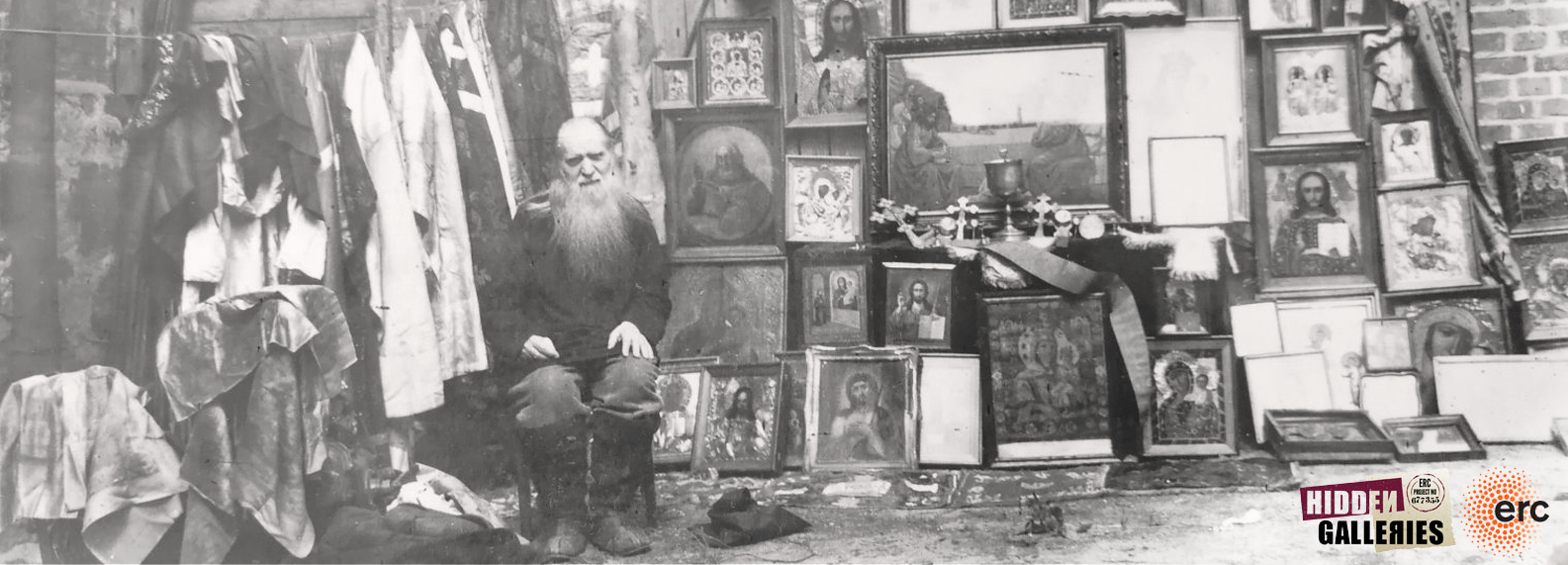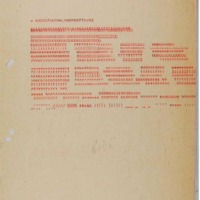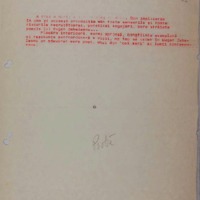Romanian secret police investigative methods Operation Leaflet
Item
Title
Romanian secret police investigative methods Operation Leaflet
Metode de investigare ale poliției secrete din România în operațiunea Apelul
Description
The four images of documents selected here come from a documentary file on the “Catholic problem” and represent clues and evidence used by the Secret Police in order to identify the culprit who wrote a leaflet that requested that at a certain hour on the feast of the Virgin’s Ascension all Greek Catholics, Roman Catholics and friends of the Church should go into the former Greek Catholic churches and say a prayer so that God would grant Nicolae Ceaușescu wisdom to legalize the Greek Catholic Church. The four documents come from volume 6, 10 and 39 of the file and represent forensic sketches used by the Secret Police in identifying the culprit who wrote the leaflet, two typed pages with typewriter alphabet and text, picture of fingerprints on photos from suspected individuals. All these were part of Securitate’s arsenal of methods in capturing the person that initiated the original leaflet.
Operațiunea Apelul (Operation Leaflet) was the code name the Securitate gave to the search for the Greek Catholic person or group that wrote a leaflet/ series of leaflets signed by the Committee for the Salvation of the Romanian Greek Catholic Church in 1977. The leaflets were mailed to hundreds of addresses and spread to numerous catholic communities, apartments, churches quickly papering the whole country. Having the underground bishops and most of the more problematic voices of the Greek Catholic dissenters under surveillance the secret police was taken by surprise by this action especially because they had no idea who could have signed the leaflet and orchestrated this operation. From that moment onwards a huge sweep up operation began. The Securitate interrogated all their informants and all the underground bishops and priests. The secret police reactivated all their former informants and created new ones just so they could find who was responsible for the leaflet. For a long while they could not find anything, since nobody knew or was willing to talk about who the Committee for the Salvation of the Romanian Greek Catholic Church was. Thus, the Securitate officers changed tactics. They knew the post offices where the original letters were mailed from and had the original leaflet typed. They interrogated the post office employees and together with criminalists and a sketch artist they drew up several portrete robot (forensic sketches) that presumably represented the people who posted the letters and leaflets. They started to call in Greek Catholics, reactivating several databases of underground believers and clergy, to check their typewriter fonts so they would match the text the secret police had with the typewriter it was written on. This whole process extended over seven years with numerous resources put into the operation. Several arrests were made before they narrowed the search down to Fr. Mihai Pop, a Greek Catholic priest from Cluj.
The images come from file CNSAS D69 (volume 6, 10, 39). The file has over 100 volumes on the catholic problem in Romania and documents and photographs on Operation Leaflet appear throughout the file. Along with these images there are interrogation reports, personal files, surveillance reports, surveillance images, confiscated leaflets and propaganda materials.
Operațiunea Apelul (Operation Leaflet) was the code name the Securitate gave to the search for the Greek Catholic person or group that wrote a leaflet/ series of leaflets signed by the Committee for the Salvation of the Romanian Greek Catholic Church in 1977. The leaflets were mailed to hundreds of addresses and spread to numerous catholic communities, apartments, churches quickly papering the whole country. Having the underground bishops and most of the more problematic voices of the Greek Catholic dissenters under surveillance the secret police was taken by surprise by this action especially because they had no idea who could have signed the leaflet and orchestrated this operation. From that moment onwards a huge sweep up operation began. The Securitate interrogated all their informants and all the underground bishops and priests. The secret police reactivated all their former informants and created new ones just so they could find who was responsible for the leaflet. For a long while they could not find anything, since nobody knew or was willing to talk about who the Committee for the Salvation of the Romanian Greek Catholic Church was. Thus, the Securitate officers changed tactics. They knew the post offices where the original letters were mailed from and had the original leaflet typed. They interrogated the post office employees and together with criminalists and a sketch artist they drew up several portrete robot (forensic sketches) that presumably represented the people who posted the letters and leaflets. They started to call in Greek Catholics, reactivating several databases of underground believers and clergy, to check their typewriter fonts so they would match the text the secret police had with the typewriter it was written on. This whole process extended over seven years with numerous resources put into the operation. Several arrests were made before they narrowed the search down to Fr. Mihai Pop, a Greek Catholic priest from Cluj.
The images come from file CNSAS D69 (volume 6, 10, 39). The file has over 100 volumes on the catholic problem in Romania and documents and photographs on Operation Leaflet appear throughout the file. Along with these images there are interrogation reports, personal files, surveillance reports, surveillance images, confiscated leaflets and propaganda materials.
Cele patru imagini ale documentelor selectate aici provin dintr-un dosar documentar despre „problema catolică” și reprezintă indicii și dovezi folosite de poliția secretă pentru a identifica vinovatul care a scris un manifest apel în care a solicitat ca la o anumită oră de sărbătoarea Adormirea Maicii Domnului, toți creștinii greco-catolici, romano-catolici și prietenii acestor biserici ar trebui să meargă în fostele biserici greco-catolice și să spună o rugăciune pentru ca Dumnezeu să-i acorde lui Nicolae Ceaușescu înțelepciune pentru a legaliza Biserica Greco-Catolică. Cele patru documente provin din volumele 6, 10 și 39 ale dosarului și reprezintă schițe criminalistice folosite de poliția secretă în identificarea vinovatului care a scris apelul, două pagini dactilografiate cu alfabetul și textul mașinii de scris, poza amprentelor digitale pe fotografii de la persoane suspectate. Toate acestea făceau parte din arsenalul de metode al Securității în capturarea persoanei care a inițiat manifestul original.
Operațiunea Apelul a fost numele de cod pe care Securitatea l-a dat căutării persoanei sau grupului greco-catolic care a scris un apel/ o serie de manifeste semnate de Comitetul pentru Salvarea Bisericii Greco-Catolice Române în anul 1977. Manifestele au fost trimise prin poștă la sute de adrese și răspândite în numeroase comunități catolice, apartamente, biserici care împânzeau rapid întreaga țară. Având sub supraveghere episcopii clandestini și majoritatea vocilor mai problematice ale disidenților greco-catolici, poliția secretă a fost surprinsă de această acțiune, mai ales că nu știau cine ar fi putut semna apelul și ar fi orchestrat această acțiune. Din acel moment, a început o operațiune uriașă de supraveghere. Securitatea i-a interogat pe toți informatorii lor și pe toți episcopii și preoții clandestini. Poliția secretă și-a reactivat toți foștii informatori și a creat pe unii noi tocmai pentru a găsi cine era responsabil pentru pliant. Multă vreme nu au putut găsi nimic, deoarece nimeni nu știa sau nu era dispus să vorbească despre ce era Comitetul pentru Salvarea Bisericii Greco-Catolice Române și cine erau cei implicați în conducerea lui. Astfel, ofițerii Securității au schimbat tactica. Știau oficiile poștale de unde fuseseră expediate scrisorile originale și aveau tipărit originalul. Au interogat angajații oficiului poștal și, împreună cu criminaliști și un portretist, au întocmit mai multe portrete robot (schițe criminalistice) care probabil reprezentau pe oamenii care au postat scrisorile și apelurile. Au început să apeleze la greco-catolici, reactivând mai multe baze de date ale credincioșilor și clericilor clandestini, pentru a le verifica fonturile de la mașina de scris, astfel încât să se potrivească cu textul pe care îl avea poliția secretă cu mașina de scris la care acesta fusese scris. Întregul proces s-a extins pe parcursul a șapte ani, cu numeroase resurse puse în funcțiune. Mai multe arestări au fost făcute înainte de a restrânge căutarea la Mihai Pop, un preot greco-catolic din Cluj.
Imaginile provin din dosarul CNSAS D69 (volumele 6, 10 şi 39). Dosarul are peste 100 de volume despre problema catolică din România iar documente și fotografii din Operațiunea Apelul apar în întregul dosar. Alături de aceste imagini există rapoarte de interogare, dosare personale, rapoarte de supraveghere, imagini de supraveghere, pliante confiscate și materiale de propagandă.
Operațiunea Apelul a fost numele de cod pe care Securitatea l-a dat căutării persoanei sau grupului greco-catolic care a scris un apel/ o serie de manifeste semnate de Comitetul pentru Salvarea Bisericii Greco-Catolice Române în anul 1977. Manifestele au fost trimise prin poștă la sute de adrese și răspândite în numeroase comunități catolice, apartamente, biserici care împânzeau rapid întreaga țară. Având sub supraveghere episcopii clandestini și majoritatea vocilor mai problematice ale disidenților greco-catolici, poliția secretă a fost surprinsă de această acțiune, mai ales că nu știau cine ar fi putut semna apelul și ar fi orchestrat această acțiune. Din acel moment, a început o operațiune uriașă de supraveghere. Securitatea i-a interogat pe toți informatorii lor și pe toți episcopii și preoții clandestini. Poliția secretă și-a reactivat toți foștii informatori și a creat pe unii noi tocmai pentru a găsi cine era responsabil pentru pliant. Multă vreme nu au putut găsi nimic, deoarece nimeni nu știa sau nu era dispus să vorbească despre ce era Comitetul pentru Salvarea Bisericii Greco-Catolice Române și cine erau cei implicați în conducerea lui. Astfel, ofițerii Securității au schimbat tactica. Știau oficiile poștale de unde fuseseră expediate scrisorile originale și aveau tipărit originalul. Au interogat angajații oficiului poștal și, împreună cu criminaliști și un portretist, au întocmit mai multe portrete robot (schițe criminalistice) care probabil reprezentau pe oamenii care au postat scrisorile și apelurile. Au început să apeleze la greco-catolici, reactivând mai multe baze de date ale credincioșilor și clericilor clandestini, pentru a le verifica fonturile de la mașina de scris, astfel încât să se potrivească cu textul pe care îl avea poliția secretă cu mașina de scris la care acesta fusese scris. Întregul proces s-a extins pe parcursul a șapte ani, cu numeroase resurse puse în funcțiune. Mai multe arestări au fost făcute înainte de a restrânge căutarea la Mihai Pop, un preot greco-catolic din Cluj.
Imaginile provin din dosarul CNSAS D69 (volumele 6, 10 şi 39). Dosarul are peste 100 de volume despre problema catolică din România iar documente și fotografii din Operațiunea Apelul apar în întregul dosar. Alături de aceste imagini există rapoarte de interogare, dosare personale, rapoarte de supraveghere, imagini de supraveghere, pliante confiscate și materiale de propagandă.
Subject
Secret Police
Communism and religion
Evidence photographs
Minority religious groups
Communism--History--20th century
Surveillance
Religion -- History -- 20th century
Catholic Church--Byzantine rite, Greek
Creator
Anca Sincan
Source
Consiliul Național pentru Studierea Arhivelor Securității (CNSAS) D69, vol 6, 10, 39
Publisher
This project has received funding from the European Research Council (ERC) under the European Union’s Horizon 2020 research and innovation programme No . 677355
Date
1977-1985
Contributor
Anca Sincan
Rights
Copyright for these images belongs to CNSAS
Consiliul Național pentru Studierea Arhivelor Securității
Consiliul Național pentru Studierea Arhivelor Securității
Format
jpeg
Language
RO
Type
Image
Text
Identifier
CNSAS, D69
Coverage
20th century, Romania
Bibliographic Citation
Anca Sincan, Romanian secret police investigative methods Operation Leaflet
Date Created
2019




